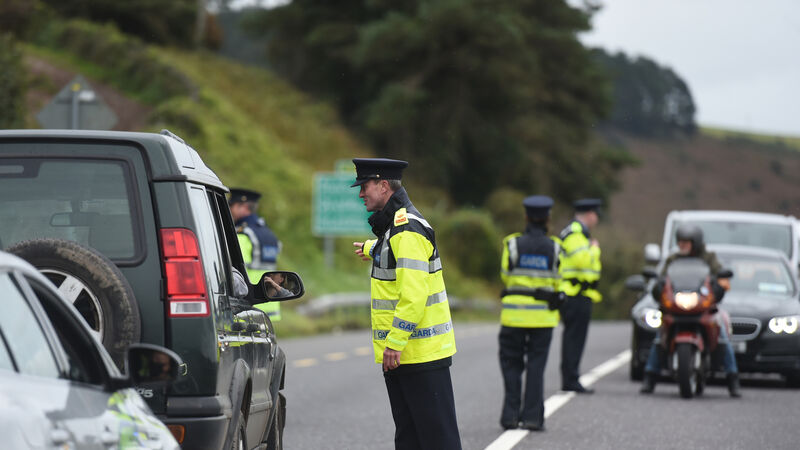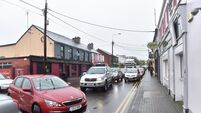Maresa Fagan: Are level 5 restrictions crushing Covid-19 three weeks into Lockdown 2.0?

Gardaí operating a checkpoint near Youghal, Co Cork close to the county boundary with Co Waterford as the level 5 restrictions begun last month. Picture: Larry Cummins
We’re halfway into Lockdown 2.0 and all the signs suggest that we’re crushing the Covid-19 curve again. Since moving into level 5 restriction three weeks ago, the national infection rate has almost halved from over 300 cases per 100,000 population to 160 cases per 100,000 population this week.
That downward trend can be seen across the country where Covid-19 hotspots have seen dramatic falls in infection rates, although there is still some way to go, the latest figures suggest.
When the second national lockdown was announced, the reproductive or R number stood at between 1.3 -1.4 and the number of new cases being confirmed every day soared past 1,000, while the seven-day positivity rate was 7%.
At that time Cavan, Donegal and Monaghan were already on level 4 restrictions following a recent surge in infections, while the rest of the country was at level 3 plus restrictions.
On October 21, as the entire country went into Lockdown 2.0, there were more than 300 people in hospital with Covid-19 on any given day and the number requiring intensive care was climbing past 30.
The move came two weeks after the National Public Health Emergency Team (Nphet) recommended moving to the highest level of restrictions.
The political reaction to a weekend leak of that Nphet advice was that the country was not ready and that the experts had not thought things through.
The leak on October 4, however, may have jolted each of us into better adherence to public health guidelines and limiting our social interactions even before Lockdown 2.0 became official.
Over the space of four weeks the national infection rate (cases per 100,000 population) rocketed from 177 on October 12, to 307 by October 26, to fall to 161 this week.
The falling infection rate is also evident at a more local level with dramatic falls in Cavan and other counties with Covid-19 hotspots.
The Ballyjamesduff electoral area, for example, had the highest infection rate in the country on October 12 at 651 cases per 100,000 population and saw the infection rate explode within two weeks to reach almost 1,500 cases per 100,000 population.
Cork City South Central was not far behind, at 566 cases per 100,000 population on October 12 and saw rates rise to 625 cases per 100,000 population by October 26.
The drama, however, happened a week later when by November 2 infection rates halved in some hotspot areas and fell significantly in others.
In Ballyjamesduff, the infection rate more than halved, from a dizzying 1,484 cases per 100 population to 593 cases per 100,000 population within a week.
Likewise, the infection rate in Cork City South Central nosedived from above 600 to 346.5 cases per 100,000 population by November 2.
Elsewhere across the country, the fall in infection rates is steady but less dramatic, suggesting there is still some way to go before we reach the Nphet goal of getting to fewer than 100 new cases of Covid-19 per day.
After three weeks of Lockdown 2.0, the R number is now below one. The national infection rate is almost halved. The positivity test rate is now below 4%. And daily case numbers fell to their lowest level this week since late September.
Of concern, however, is the number of deaths and number of people in hospital and requiring intensive care for Covid-19.
While showing signs of tapering off since October, the number of fatalities and hospitalisations may dash any hopes of the country easing out of level 5 restrictions before December
In the month of October, 119 people died from Covid-19. So far in November, the number of fatalities stands at 36 people.
Fortunately, the virus has, in the main, been kept out of nursing homes and other vulnerable settings in this second wave but the risks remain and that will be the primary concern of Nphet when it reviews the epidemiological evidence in the coming weeks.
For now, nationally, we are back to where we were in mid-October when concerns remained about the rapid spread of the virus in the community. So we’re not on the home stretch yet.
Nphet and the Government’s goal is the crush the second wave; to achieve an R number of 0.5 or less than 100 new cases per day. We’re on the way there but we’re not there yet.
And while the immediate focus is a laudable one, there is still the question of what happens next? Where does the country go from here and what is the medium-term strategy?
Will we be released from level 5 restrictions to celebrate Christmas only to face a third Covid-19 wave in the New Year followed by Lockdown 3.0? That’s the burning question that has yet to be answered.
It is only fair to the thousands of already exhausted healthcare staff who are keeping our health service running despite the risks and challenges. It is only fair to the hundreds of thousands of patients languishing on waiting lists for non-Covid care. It is only fair for the thousands of employers and their employees in shuttered businesses, who long to reopen their doors. It is only fair to each and every one of us who has made sacrifices this year in the name of crushing the Covid-19 curve and protecting friends, family, and the vulnerable.
The Government’s plan for ‘Living with Covid-19’ does not provide a roadmap out of the pandemic. After December and Christmas comes and goes, we will still need an exit strategy.
News of a vaccine breakthrough was welcome this week. If nothing else, it offers hope that there may be an end in sight.
For the moment, though, we’re tinkering around the edges of the Covid-19 crisis instead of having an open and honest dialogue on where we’re going in the longer term and where we might be in six or 12 months.
Most of us cannot wait to see the back of 2020. The question remains; will 2021 be much different?













